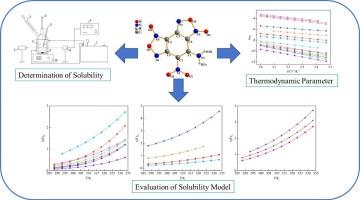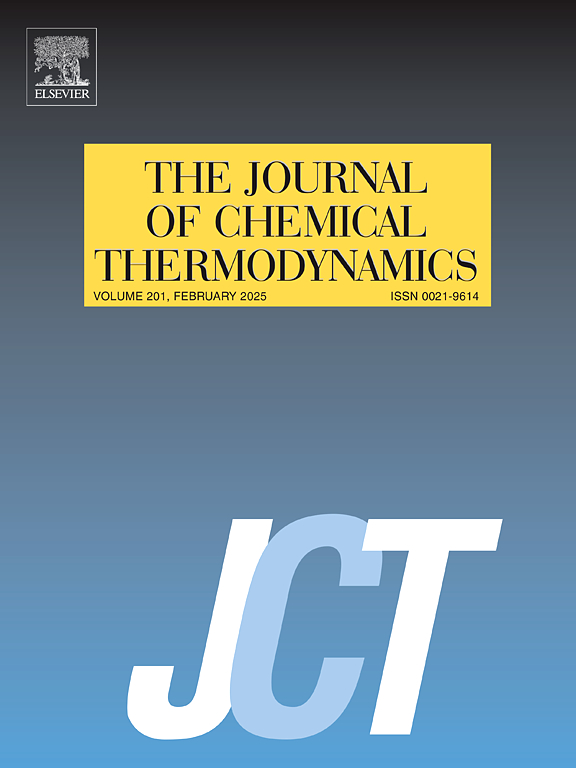Measurement and correlation solubility of 7-amino-6-nitrobenzodifuroxan in fifteen pure solvents from 288.15 to 333.15 K
IF 2.2
3区 工程技术
Q3 CHEMISTRY, PHYSICAL
引用次数: 0
Abstract
7-Amino-6-nitrobenzodifuroxan (ANBDF) solubility was determined using a laser dynamic technique from 288.15 K to 333.15 K under 0.1 MPa in fifteen pure solvents, including methanol, ethanol, acetone, cyclohexanone, ethyl acetate, acetonitrile, dichloromethane, 1,2-dichloroethane, ethanoic acid, propanoic acid, toluene, o-xylene, N-Methylpyrrolidone (NMP), N,N-Dimethylformamide (DMF), Dimethyl sulfoxide (DMSO). ANBDF might become more soluble in fifteen pure solvents as the temperature rose. At 298.15 K, the following substances dissolve ANBDF in the following order: DMSO > NMP > DMF > cyclohexanone > acetone > acetonitrile > ethyl acetate > ethanoic acid >1,2-dichloroethane > o-xylene > propanoic acid > methanol > dichloromethane > toluene > ethanol. The KAT-LSER model was used to study the influence of the solvent, and it revealed that the acidity of the solvents' hydrogen bonds has a stronger impact on the solubility of ANBDF. The solubility of ANBDF was correlated using van't Hoff equation, modified Apelblat equation, Yaws equation and polynomial empirical equation. In addition, thermodynamic parameters such as the standard dissolution enthalpy, standard dissolution entropy, and standard Gibbs free energy were calculated based on the experimental solubility values. The dissolution process of ANBDF could be an enthalpy-driven, non-spontaneous and endothermic process in fifteen pure solvents. The measurement and fitting solubility of ANBDF have important guiding significance for the purification and crystallization of its preparation process.

7-氨基-6-硝基苯并二硝基呋星在288.15 ~ 333.15 K 15种纯溶剂中的溶解度测定及相关溶解度
采用激光动力学技术测定了7-氨基-6-硝基苯并二硝基呋喃(ANBDF)在0.1 MPa、288.15 K ~ 333.15 K范围内,在甲醇、乙醇、丙酮、环己酮、乙酸乙酯、乙腈、二氯甲烷、1,2-二氯乙烷、乙醇酸、丙酸、甲苯、邻二甲苯、N-甲基吡罗烷酮(NMP)、N,N-二甲基甲酰胺(DMF)、二甲基亚砜(DMSO)等15种纯溶剂中的溶解度。随着温度的升高,ANBDF可能在15种纯溶剂中更容易溶解。在298.15 K时,下列物质按顺序溶解ANBDF: DMSO >;NMP祝辞DMF祝辞环己酮在丙酮比;乙腈比;乙酸乙酯>;乙酸>;1,2-二氯乙烷>;邻二甲苯的在丙酸>;甲醇比;二氯甲烷比;甲苯比;乙醇。利用KAT-LSER模型研究了溶剂的影响,发现溶剂氢键的酸度对ANBDF的溶解度有较大的影响。利用van't Hoff方程、修正Apelblat方程、Yaws方程和多项式经验方程对ANBDF的溶解度进行了相关性分析。根据实验溶解度值计算了标准溶解焓、标准溶解熵和标准吉布斯自由能等热力学参数。ANBDF在15种纯溶剂中的溶解过程为焓驱动、非自发和吸热过程。ANBDF溶解度的测定和拟合对其制备过程的纯化和结晶具有重要的指导意义。
本文章由计算机程序翻译,如有差异,请以英文原文为准。
求助全文
约1分钟内获得全文
求助全文
来源期刊

Journal of Chemical Thermodynamics
工程技术-热力学
CiteScore
5.60
自引率
15.40%
发文量
199
审稿时长
79 days
期刊介绍:
The Journal of Chemical Thermodynamics exists primarily for dissemination of significant new knowledge in experimental equilibrium thermodynamics and transport properties of chemical systems. The defining attributes of The Journal are the quality and relevance of the papers published.
The Journal publishes work relating to gases, liquids, solids, polymers, mixtures, solutions and interfaces. Studies on systems with variability, such as biological or bio-based materials, gas hydrates, among others, will also be considered provided these are well characterized and reproducible where possible. Experimental methods should be described in sufficient detail to allow critical assessment of the accuracy claimed.
Authors are encouraged to provide physical or chemical interpretations of the results. Articles can contain modelling sections providing representations of data or molecular insights into the properties or transformations studied. Theoretical papers on chemical thermodynamics using molecular theory or modelling are also considered.
The Journal welcomes review articles in the field of chemical thermodynamics but prospective authors should first consult one of the Editors concerning the suitability of the proposed review.
Contributions of a routine nature or reporting on uncharacterised materials are not accepted.
 求助内容:
求助内容: 应助结果提醒方式:
应助结果提醒方式:


